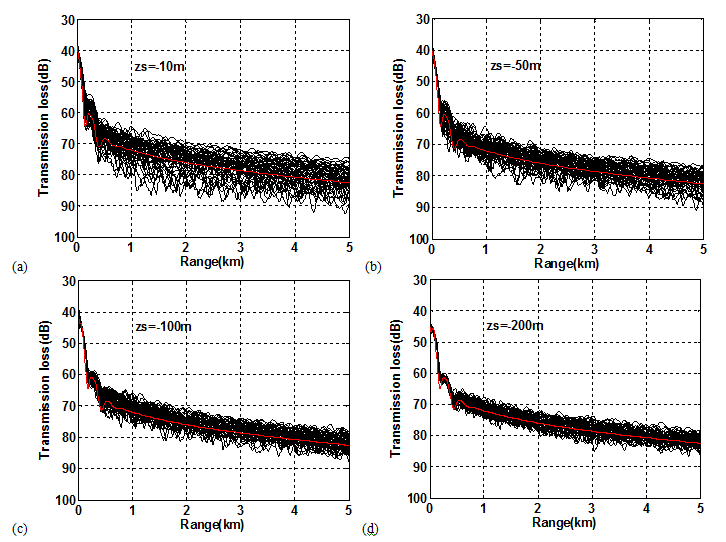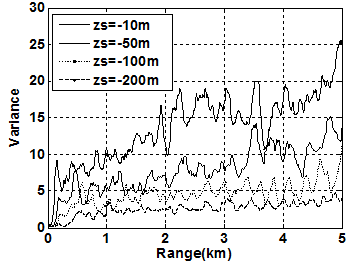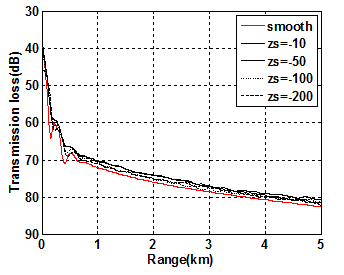With the rapid development in the aircraft industry, the underwater sound field stimulated by aircrafts causes extensive concern. After the air-to-water sound transmission has been studied, it shows that, when the underwater waveguide has a smooth sea surface, the source height mostly impacts the phase of the sound field. And, its effect on the amplitude is neglectable.
Actually, the sea surface is randomly rough, and it induces the change of both the incident angle and the insonifying cone. The effect of a randomly rough boundary on the sound field has been studied by the coupling normal-mode method and the self-consistent perturbation approach. However, there are few research about the relationship between the air-to-water sound transmission and the source’s height in underwater waveguide with a rough sea surface.
The self-consistent perturbation approach is more efficient to get the statistical results of the sound field and can be easily implemented. As a result, researchers from the Institute of Acoustics, Chinese Academy of Sciences apply it to study the effect of the source’s height on the underwater sound field when the interface’s roughness is small-scale.
According to the self-consistent perturbation approach, the total field is decomposed into the mean field and the scattered field. With a small-scale rough sea surface, the effect of the source’s height on the mean field can be ignored. Numerical simulation aims to illustrate the relation between the source’s height and the scattered field.
When the wind-speed is 5 m/s and the frequency is 20 Hz, transmission losses of the total field (black solid curves) for different realizations of the rough sea surface (50 rough sea surface realizations) and different source’s heights are shown in Fig.1. For the reference, the transmission loss for the smooth boundary (red curve) is also shown. The four figures show that as the source’s height is growing, the fluctuation of the scattered field becomes small. In other words, when the source’s height is higher, the rough sea surface has a smaller impact on the scattered field. And as the range increases, the fluctuation of the scattered field becomes higher. The same conclusion can be drawn by Fig.2, which displays the variance of the total field transmission losses for 50 different realizations of the rough sea surface.
The transmission loss of the mean square field for 50 different realizations of the rough sea surface is shown in Fig.3. It is known that the source’s height rarely influences the transmission loss for the smooth sea surface. Therefore, only the transmission loss with the smooth surface at the case of source’s height of 10m (red curve) is shown in Fig.3, reflecting that the difference between the five curves is very small. This indicates the mean square field, as well as the averaged energy of the total field in the statistical sense, is almost independent of source’s heights.

Fig.1 Transmission losses of the total field (black curves) for different implements of rough sea surface with different source heights. The number of rough sea surfaces’ simulation is 50. As reference, the transmission loss for the smooth boundary is also shown as red curves.The source heights are: (a) zs=-10m (b) zs=-50m(c) zs=-100m (d) zs=-200m (Image by ZHANG).

Fig.2 Variances of transmission loss versus range for different source’s heights 10m (heavy solid curve), 50m (thin solid curve), 100m (dotted curve), and 200m (dashed curve), respectively (Image by ZHANG).

Fig.3 Comparison of transmission losses for the mean square field with different source’s heights 10m (heavy curve), 50m (thin solid curve), 100m (dotted curve), and 200m (dashed curve), respectively. As reference, the transmission loss for the smooth boundary with source’s height 10m is also shown in red curve (Image by ZHANG).
References:
ZHANG Lingshan, PENG Zhaohui. Effect of Source's Height on Air-to-Water Sound Transmission with a Small-Scale Rough Sea Surface.Chinese Physics Letters (vol.31, no.9, pp.094302-1~094302-5, September 2014).DOI:10.1088/0256-307X/31/9/094302
Contact:
ZHANG Lingshan
State Key Laboratory of Acoustics, Institute of Acoustics, Chinese Academy of Sciences, 100190 Beijing, China
Email: zhanglingshan@mail.ioa.ac.cn


